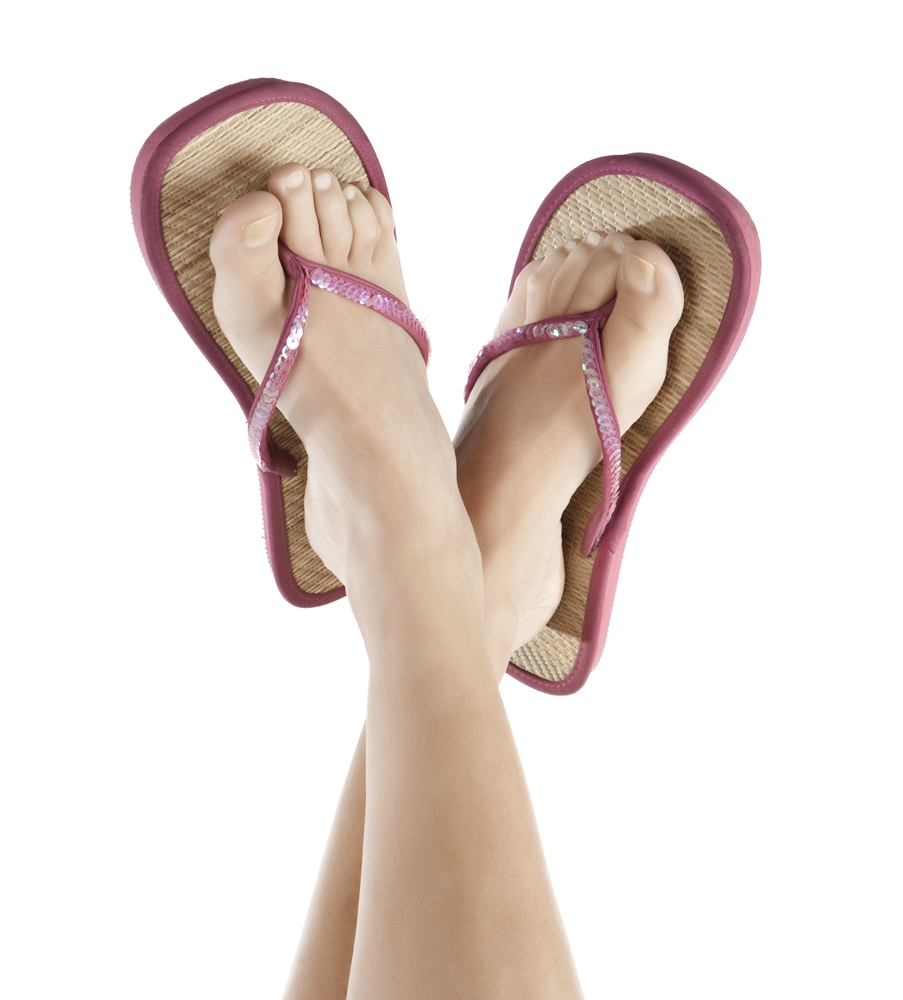 Research has indicated that flip flops may be damaging to your feet, and may negatively affect the overall health of the body. There are several foot conditions that can develop from wearing this type of shoe. These include heel pain which may lead to heel spurs or plantar fasciitis, Achilles tendonitis, bruises and blisters. While flip flops are being worn, the arch of the foot lacks support, and this can cause pain in the heel and middle of the foot. Additionally, the toes will typically become strained from attempting to keep the shoe on the foot. Tripping and falling incidents may increase, which can be a result of lack of support. If you would like additional information about the way flip flops affect the feet, please speak to a podiatrist who can answer any questions you may have.
Research has indicated that flip flops may be damaging to your feet, and may negatively affect the overall health of the body. There are several foot conditions that can develop from wearing this type of shoe. These include heel pain which may lead to heel spurs or plantar fasciitis, Achilles tendonitis, bruises and blisters. While flip flops are being worn, the arch of the foot lacks support, and this can cause pain in the heel and middle of the foot. Additionally, the toes will typically become strained from attempting to keep the shoe on the foot. Tripping and falling incidents may increase, which can be a result of lack of support. If you would like additional information about the way flip flops affect the feet, please speak to a podiatrist who can answer any questions you may have.
Flip-flops are not always the best choice of footwear. If you have any concerns about your feet or ankles, contact Bruce Smit, DPM from Frankfort Foot & Ankle Clinic. Our doctor will assist you with all of your foot and ankle needs.
Flip-Flops and Feet
When the weather starts warming up, people enjoy wearing flip-flops. Flip-flops are comfortable, stylish, and easy to slip on and off; they're perfect for any summer beach goer. However, these shoes can cause harm to the feet.
How Can Flip-Flops Affect Me Long-Term?
Are There Injuries Associated with Flip-Flops?
Yes. Since flip-flops are relatively weak and do not provide the same amount of support as sneakers, people who wear flip-flops regularly are more susceptible to injuries. On top of that, the open nature of the shoe makes your feet more prone to other problems, such as cuts and even infections. Common injuries and ailments include:
I like Wearing Flip-Flops. Are There Safe Alternatives?
When buying flip-flops, try to find ones that have sturdy soles and that are made of high-quality materials that will support for your feet. These flip-flops will cost more but will also last longer as a result.
If you have any questions please feel free to contact our office located in Frankfort, IL . We offer the newest diagnostic and treatment technologies for all your foot and ankle needs.
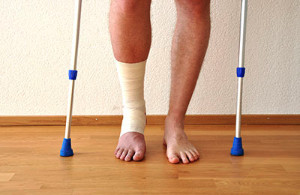 Stress fractures are tiny cracks in the bones of the feet. They occur as a result of participating in activities that cause the bones in the foot to weaken and crack faster than the healing process can begin. This can occur due to several reasons, including training in your chosen sport before adequate healing has been completed, increasing the amount of time training in a short period of time, or running on different surfaces. The symptoms that are associated with stress fractures often include swelling, burning pain, and difficulty walking on the affected foot. Effective treatment begins with staying off the foot for several weeks, depending on the severity of the injury. This can be accomplished by wearing a cast. If you have sustained a stress fracture, speak to a podiatrist who can guide you toward proper treatment options.
Stress fractures are tiny cracks in the bones of the feet. They occur as a result of participating in activities that cause the bones in the foot to weaken and crack faster than the healing process can begin. This can occur due to several reasons, including training in your chosen sport before adequate healing has been completed, increasing the amount of time training in a short period of time, or running on different surfaces. The symptoms that are associated with stress fractures often include swelling, burning pain, and difficulty walking on the affected foot. Effective treatment begins with staying off the foot for several weeks, depending on the severity of the injury. This can be accomplished by wearing a cast. If you have sustained a stress fracture, speak to a podiatrist who can guide you toward proper treatment options.
Stress fractures occur when there is a tiny crack within a bone. To learn more, contact Bruce Smit, DPM from Frankfort Foot & Ankle Clinic. Our doctor can provide the care you need to keep you pain free and on your feet.
How Are They Caused?
Stress fractures are the result of repetitive force being placed on the bone. Since the lower leg and feet often carry most of the body’s weight, stress fractures are likely to occur in these areas. If you rush into a new exercise, you are more likely to develop a stress fracture since you are starting too much, too soon. Pain resulting from stress fractures may go unnoticed at first, however it may start to worsen over time.
Risk Factors
Stress fractures do not always heal properly, so it is important that you seek help from a podiatrist if you suspect you may have one. Ignoring your stress fracture may cause it to worsen, and you may develop chronic pain as well as additional fractures.
If you have any questions, please feel free to contact our office located in Frankfort, IL . We offer the newest diagnostic and treatment technologies for all your foot care needs.
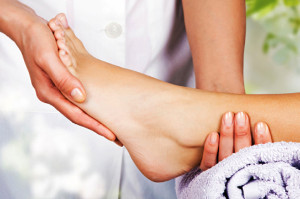 Patients who have foot pain can benefit from different types of foot therapy. When the feet are soaked in warm water, mild relief may be found. This is helpful in relaxing sore foot muscles. Additionally, having foot massages performed can aid in reducing tension in the body, improving circulation, and may ease any pain that is present. When the toes are spread apart, the muscles that lie underneath are stretched, and this may help to strengthen the entire foot. There are some patients who find it beneficial to use topical treatments which include eucalyptus oil.This provides a different sensation, and may help in relieving existing foot pain. If you would like to learn of additional types of foot therapy, it is advised to schedule a consultation with a podiatrist who can properly guide you.
Patients who have foot pain can benefit from different types of foot therapy. When the feet are soaked in warm water, mild relief may be found. This is helpful in relaxing sore foot muscles. Additionally, having foot massages performed can aid in reducing tension in the body, improving circulation, and may ease any pain that is present. When the toes are spread apart, the muscles that lie underneath are stretched, and this may help to strengthen the entire foot. There are some patients who find it beneficial to use topical treatments which include eucalyptus oil.This provides a different sensation, and may help in relieving existing foot pain. If you would like to learn of additional types of foot therapy, it is advised to schedule a consultation with a podiatrist who can properly guide you.
Foot therapy is often necessary for those recovering from either foot deformities or foot injuries. If you have concerns regarding therapy, consult with Bruce Smit, DPM from Frankfort Foot & Ankle Clinic. Our doctor can provide the care you need to keep you pain-free and on your feet.
Most Common Injuries
People who are active or athletes are prone to a variety of injuries. Therefore, it is often important to take part in physical therapy in order to quickly get back on the right track.
What to Do When Injured
Physical Therapy – This specialized treatment will focus on the affected area, speeding up recovery and the overall healing process. It is a proven method that has helped millions of people return from any injury.
During physical therapy you will undergo regimented training to get back into full form. Training is often very difficult, especially at first when the foot feels weak. Physical therapy often involves:
Basic stretching and twisting exercises – getting the feet’s mobility and flexibility up.
Massaging – the therapist will massage the injured area in order to activate the muscles and relax them.
Strengthening Exercises – this allows the muscles in the affected area to regain their full strength, a vital step towards full recovery.
If you have any questions please feel free to contact our office located in Frankfort, IL . We offer the newest diagnostic tools and technology to treat your foot and ankle needs.
 Sever’s disease only affects children because it involves the growth plate in the heel, which is not fully developed in childhood. The growth plate is weaker than the rest of the bone, so continual pressure or injury can lead to swelling and irritation. Therefore, sports are a common cause for children developing Sever’s disease. Symptoms of this condition are swelling and redness of the heel, stiffness in the feet, limping, and heel pain. Symptoms tend to become worse during or after activities, then get better with rest. If a child participates in sporting activities, then develops Sever’s disease, they should wait until after being treated to resume those activities. If you think your child may have Sever’s disease, then it is recommended you bring them to a podiatrist in order to receive appropriate treatment.
Sever’s disease only affects children because it involves the growth plate in the heel, which is not fully developed in childhood. The growth plate is weaker than the rest of the bone, so continual pressure or injury can lead to swelling and irritation. Therefore, sports are a common cause for children developing Sever’s disease. Symptoms of this condition are swelling and redness of the heel, stiffness in the feet, limping, and heel pain. Symptoms tend to become worse during or after activities, then get better with rest. If a child participates in sporting activities, then develops Sever’s disease, they should wait until after being treated to resume those activities. If you think your child may have Sever’s disease, then it is recommended you bring them to a podiatrist in order to receive appropriate treatment.
Sever's disease often occurs in children and teens. If your child is experiencing foot or ankle pain, see Bruce Smit, DPM from Frankfort Foot & Ankle Clinic. Our doctor can treat your child’s foot and ankle needs.
Sever’s Disease
Sever’s disease is also known as calcaneal apophysitis, which is a medical condition that causes heel pain I none or both feet. The disease is known to affect children between the ages of 8 and 14.
Sever’s disease occurs when part of the child’s heel known as the growth plate (calcaneal epiphysis) is attached to the Achilles tendon. This area can suffer injury when the muscles and tendons of the growing foot do not keep pace with bone growth. Therefore, the constant pain which one experiences at the back of the heel will make the child unable to put any weight on the heel. The child is then forced to walk on their toes.
Symptoms
Acute pain – Pain associated with Sever’s disease is usually felt in the heel when the child engages in physical activity such as walking, jumping and or running.
Highly active – Children who are very active are among the most susceptible in experiencing Sever’s disease, because of the stress and tension placed on their feet.
If you have any questions, please feel free to contact our office located in Frankfort, IL . We offer the newest diagnostic and treatment technologies for all your foot and ankle injuries.
 If your child complains of pain on the side of the big toe, it may be indicative of an ingrown toenail. Additional symptoms include swelling and redness in the corner of the affected toe, difficulty in walking, and possible drainage. This condition typically develops as a result of toenails that are trimmed incorrectly, or from wearing shoes that do not fit properly. Mild relief can be obtained from soaking the affected nail in warm water, which may help to soften the nail. If the symptoms become severe, it is advised to speak to a podiatrist as quickly as possible, so proper treatment can begin.
If your child complains of pain on the side of the big toe, it may be indicative of an ingrown toenail. Additional symptoms include swelling and redness in the corner of the affected toe, difficulty in walking, and possible drainage. This condition typically develops as a result of toenails that are trimmed incorrectly, or from wearing shoes that do not fit properly. Mild relief can be obtained from soaking the affected nail in warm water, which may help to soften the nail. If the symptoms become severe, it is advised to speak to a podiatrist as quickly as possible, so proper treatment can begin.
Ingrown toenails can become painful if they are not treated properly. For more information about ingrown toenails, contact Bruce Smit, DPM of Frankfort Foot & Ankle Clinic. Our doctor can provide the care you need to keep you pain-free and on your feet.
Ingrown Toenails
Ingrown toenails occur when a toenail grows sideways into the bed of the nail, causing pain, swelling, and possibly infection.
Causes
Prevention
Because ingrown toenails are not something found outside of shoe-wearing cultures, going barefoot as often as possible will decrease the likeliness of developing ingrown toenails. Wearing proper fitting shoes and using proper cutting techniques will also help decrease your risk of developing ingrown toenails.
Treatment
Ingrown toenails are a very treatable foot condition. In minor cases, soaking the affected area in salt or antibacterial soaps will not only help with the ingrown nail itself, but also help prevent any infections from occurring. In more severe cases, surgery is an option. In either case, speaking to your podiatrist about this condition will help you get a better understanding of specific treatment options that are right for you.
If you have any questions please feel free to contact our office located in Frankfort, IL . We offer the newest diagnostic and treatment technologies for all your foot and ankle needs.
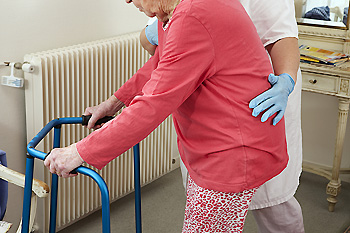 Many elderly people who fall may find difficulty in getting up without assistance. Research has shown that twenty percent of people in their mid-sixties will endure a fall, and many of these falls may lead to serious injuries. This is one reason why it is important to implement methods to help prevent falling. These may include learning about side effects that may occur while existing medications are taken, wearing glasses, using hearing aids consistently, and removing any clutter in the home that may be present. It may also be helpful to wear shoes that fit correctly, and using grab bars in the bathroom and shower area can play a significant role in preventing falls. If you would like additional information about the importance of falls prevention, please consult with a podiatrist.
Many elderly people who fall may find difficulty in getting up without assistance. Research has shown that twenty percent of people in their mid-sixties will endure a fall, and many of these falls may lead to serious injuries. This is one reason why it is important to implement methods to help prevent falling. These may include learning about side effects that may occur while existing medications are taken, wearing glasses, using hearing aids consistently, and removing any clutter in the home that may be present. It may also be helpful to wear shoes that fit correctly, and using grab bars in the bathroom and shower area can play a significant role in preventing falls. If you would like additional information about the importance of falls prevention, please consult with a podiatrist.
Preventing falls among the elderly is very important. If you are older and have fallen or fear that you are prone to falling, consult with Bruce Smit, DPM from Frankfort Foot & Ankle Clinic. Our doctor will assess your condition and provide you with quality advice and care.
Every 11 seconds, an elderly American is being treated in an emergency room for a fall related injury. Falls are the leading cause of head and hip injuries for those 65 and older. Due to decreases in strength, balance, senses, and lack of awareness, elderly persons are very susceptible to falling. Thankfully, there are a number of things older persons can do to prevent falls.
How to Prevent Falls
Some effective methods that older persons can do to prevent falls include:
Falling can be a traumatic and embarrassing experience for elderly persons; this can make them less willing to leave the house, and less willing to talk to someone about their fears of falling. Doing such things, however, will increase the likelihood of tripping or losing one’s balance. Knowing the causes of falling and how to prevent them is the best way to mitigate the risk of serious injury.
If you have any questions, please feel free to contact our office located in Frankfort, IL . We offer the newest diagnostic and treatment technologies for all your foot care needs.
It is known that the feet are the foundation of the body. Many people tend to ignore their feet until some type of pain is felt. Research has indicated that when frequent foot care is practiced, the feet and overall health of the body may be positively affected. This type of care may include washing and drying the feet daily, which may help to prevent unpleasant foot odor, or athlete’s foot. The feet will feel good after a moisturizer is applied, and this may prevent cracked heels from developing. Additionally, it is helpful to wear shoes that have adequate room for the toes to move freely in. Flip flops do not provide stability and proper arch support for the foot, and it is suggested to limit wearing these types of shoes. If you would like additional information about how to care for your feet daily, it is suggested that you consult with a podiatrist.
Everyday foot care is very important to prevent infection and other foot ailments. If you need your feet checked, contact Bruce Smit, DPM from Frankfort Foot & Ankle Clinic. Our doctor can provide the care you need to keep you pain-free and on your feet.
Everyday Foot Care
Often, people take care of their bodies, face and hair more so than they do for their feet. But the feet are a very important aspect of our bodies, and one that we should pay more attention to. Without our feet, we would not be able to perform most daily tasks.
It is best to check your feet regularly to make sure there are no new bruises or cuts that you may not have noticed before. For dry feet, moisturizer can easily be a remedy and can be applied as often as necessary to the affected areas. Wearing shoes that fit well can also help you maintain good foot health, as well as making it easier to walk and do daily activities without the stress or pain of ill-fitting shoes, high heels, or even flip flops. Wearing clean socks with closed shoes is important to ensure that sweat and bacteria do not accumulate within the shoe. Clean socks help to prevent Athlete’s foot, fungi problems, bad odors, and can absorb sweat.
If you have any questions please feel free to contact our office located in Frankfort, IL . We offer the newest diagnostic and treatment technologies for all your foot and ankle needs.
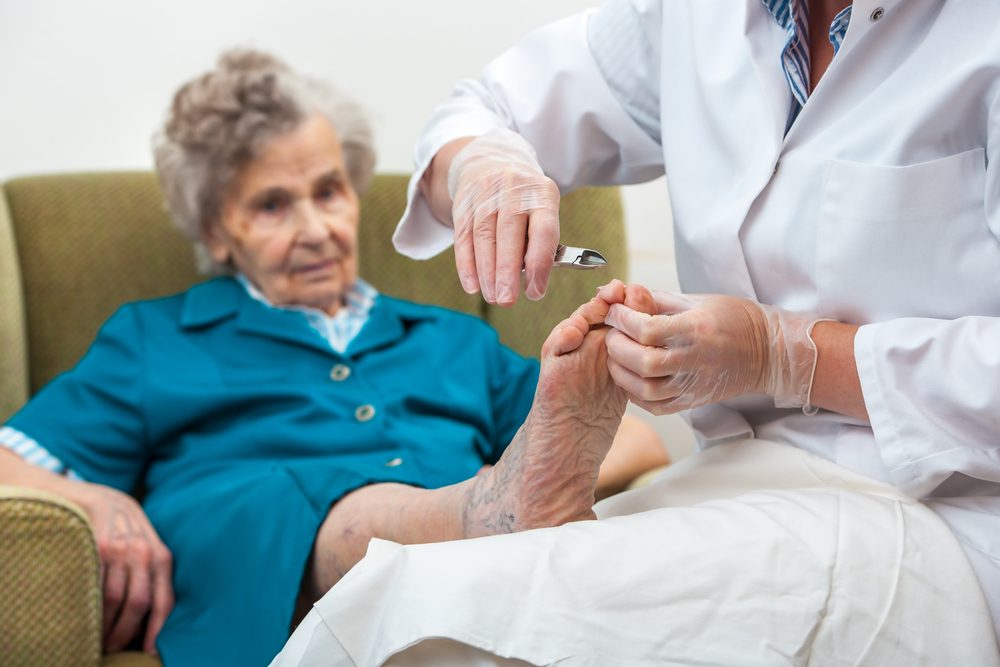 Many elderly people may experience foot problems as a result of a loss of cushioning in the feet and poor circulation. An effective way to protect the feet may be to wear shoes that fit correctly. Additionally, if standing is done for the majority of the day, the feet may feel better if gentle stretches are performed. Many patients develop athlete’s foot, which is a common fungus that attacks the bottom of the feet and between the toes. This may be prevented if the feet are washed and dried thoroughly each day, followed by wearing clean socks and shoes. It is common for seniors to have dry skin, and a symptom of this may be an itchy or burning sensation. Prevention of this may include using a moisturizer on the feet after a shower or bath is taken. If you would like additional information about how to properly care for elderly feet, please feel free to speak to a podiatrist.
Many elderly people may experience foot problems as a result of a loss of cushioning in the feet and poor circulation. An effective way to protect the feet may be to wear shoes that fit correctly. Additionally, if standing is done for the majority of the day, the feet may feel better if gentle stretches are performed. Many patients develop athlete’s foot, which is a common fungus that attacks the bottom of the feet and between the toes. This may be prevented if the feet are washed and dried thoroughly each day, followed by wearing clean socks and shoes. It is common for seniors to have dry skin, and a symptom of this may be an itchy or burning sensation. Prevention of this may include using a moisturizer on the feet after a shower or bath is taken. If you would like additional information about how to properly care for elderly feet, please feel free to speak to a podiatrist.
If you need your feet checked, contact Bruce Smit, DPM of Frankfort Foot & Ankle Clinic. Our doctor will attend to all of your foot and ankle needs and provide you with quality treatment.
Geriatrics and Podiatry
When people age, some common issues that may occur are bone density loss, dry skin, poor circulation, and rough brittle nails. These issues may also affect your foot health if the necessary steps are not taken to alleviate the problems.
It is important to take care of your feet because feet that are injured or diseased can affect your overall health. Having painful feet hinders your ability to do daily activities or may decrease your willingness to do the things that you need to do.
Visiting Your Geriatrician
As we age, health problems become more likely, so it is essential to visit your doctor for check-ups to ensure that you are doing the best you can to take care of your health. It is recommended to check your feet frequently for any possible cuts, bruises, swelling, corns or any other irregularities.
Taking Care of Elderly Feet
Cracked or dry feet can be treated by applying moisturizer often. It is also important not to wear old socks because the older the sock is, the higher the possibility there will be that there is bacteria there. Wear fresh socks and make sure they fit properly.
Proper foot health means that you can have a more active lifestyle and you will not be bogged down by pain. Foot health also leads to good circulation, which is paramount for overall health.
If you have any questions, please feel free to contact our office located in Frankfort, IL . We offer the newest diagnostic tools and technology to treat your foot and ankle needs.